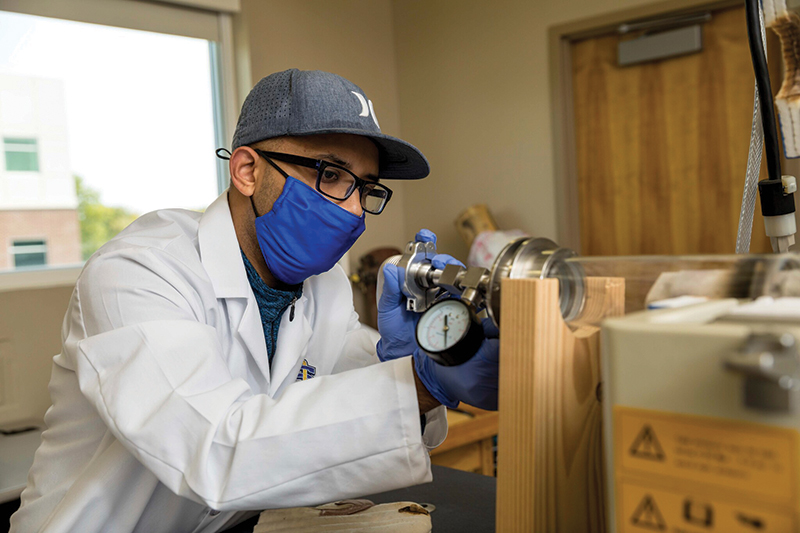A New Approach to Improving Lithium Anodes in Lithium Metal Batteries
Spring
2021
Building Blocks - Undergraduate Research and Outreach Projects
A New Approach to Improving Lithium Anodes in Lithium Metal Batteries
Abdullah Al Maruf and Ke Chen, SPS Members, South Dakota State University
Almost all modern electronic devices, as well as electric and hybrid vehicles, depend on lithium-ion batteries (LIBs). Despite major industrial efforts to create robust LIBs with high energy density and make them commercially available, their performance and efficiency have not kept pace with consumer demand for energy storage over the past decade. This is a major obstacle in transitioning to a sustainable energy-dependent future. 
This past year, our SPS chapter at South Dakota State University (SDSU) used an SPS Chapter Research Award to explore the development of another kind of lithium-based battery, a lithium (Li) metal battery. These batteries use a Li metal anode instead of the more conventional graphite anode of LIBs. Li metal has a high specific capacity of 3860 mAh/g—ten times that of graphite—which means batteries with a higher energy density can potentially be achieved.
We wanted to create a safe, high-energy-density Li metal battery, and to reach this goal we needed to tackle a crucial performance limitation of Li metal anodes—dendrite formation. When Li metal is used as an electrode, needlelike microstructures called dendrites form on the surface of the anode and grow over time during charging cycles. This is a major problem because dendrites can penetrate the separator between the anode and cathode in the battery, causing a short circuit and potentially resulting in combustive electrolytes catching fire. Using Li metal as an anode has other problems as well, such as uncontrolled interfacial reactions and degradation, and large volume changes during Li plating and stripping.
To overcome these limitations, we decided to guide the deposition behavior of the Li metal we used for the anode of our battery. We created a novel glass fiber matrix thin film called partially lithiophilic nonconductive matrix (PLNM) using amorphous silicon dioxide. We then deposited Li metal onto PLNM and studied Li plating and stripping behaviors in cells.
Using a scanning electron microscope (SEM), we compared the postcycling surface morphology of our Li-PLNM anode to a conventional graphite anode surface. Our results show that we were able to successfully suppress dendrite formation and growth on the Li-metal anode. In addition, the battery we created has a higher capacity and power density than what’s been reported in peer-reviewed journals for LIBs. Our battery performed especially well in power density, specific capacity, cycling life, and durability (battery stability). We hope that our lithium anode will be a candidate for commercial application.
Throughout this project, the major obstacle was that the lab was shut down for two and half months due to COVID-19. This meant we needed to remake samples and repeat some of the experiments. Interestingly, while our project proposal was mainly focused on experimental laboratory research, during the shutdown we explored some rigorous theoretical approaches to improving performance that we later tested experimentally in the lab. We have now written a manuscript on this work and submitted the paper to a peer-reviewed scientific journal.
This project created new undergraduate research opportunities for physics students at SDSU. Two of our team members are applying to graduate school, and this SPS research experience was particularly helpful to them, as it made a significant impact on their graduate school preparation and their future endeavors in research. This, in turn, has inspired others in the physics department to get involved in physics research.
The research team included Abdullah Al Maruf, Ke Chen, Rajesh Pathak, and Nick Carlson, and we’d like to thank Dr. Yue Zhou, Dr. Qiquan Qiao, and Dr. Robert McTaggart for their guidance.
For information on the SPS Chapter Research Awards and to apply for funding, visit spsnational.org/awards/chapter-research.
More from this department
Building Blocks - Undergraduate Research and Outreach Projects
